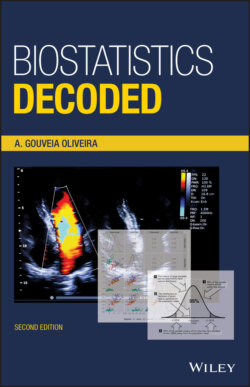Читать книгу Biostatistics Decoded - A. Gouveia Oliveira - Страница 15
1.7 The Standard Deviation
ОглавлениеLet us now consider other measures of dispersion. Another possible measure could be the average of the deviations of all individual values about the mean or, in other words, the average of the differences between each value and the mean of the distribution. This would be an interesting measure, being both a single value and easy to interpret, since it is an average. Unfortunately, it would not work because the differences from the mean in those values smaller than the mean are positive, and the differences in those values greater than the mean are negative. The result, if the values are symmetrically distributed about the mean, will always be close to zero regardless of the magnitude of the dispersion.
Actually, what we want is the average of the size of the differences between the individual values and the mean. We do not really care about the direction (or sign) of those differences. Therefore, we could use instead the average of the absolute value of the differences between each value and the mean. This quantity is called the absolute mean deviation. It satisfies the desired properties of a summary measure: single value, stability, and interpretability. The mean deviation is easy to interpret because it is an average, and people are used to dealing with averages. If we were told that the mean of some patient attribute is 256 mmol/l and the mean deviation is 32 mmol/l, we could immediately figure out that about half the values were in the interval 224–288 mmol/l, that is, 256 − 32 to 256 + 32.
There is a small problem, however. The mean deviation uses absolute values, and absolute values are quantities that are difficult to manipulate mathematically. Actually, they pose so many problems that it is standard mathematical practice to square a value when one wants the sign removed. Let us apply that method to the mean deviation. Instead of using the absolute value of the differences about the mean, let us square those differences and average the results. We will get a quantity that is also a measure of dispersion. This quantity is called the variance. The way to compute the variance is, therefore, first to find the mean, then subtract each value from the mean, square the result, and add all those values. The resulting quantity is called the sum of squares about the mean, or just the sum of squares. Finally, we divide the sum of squares by the number of observations to get the variance.
Because the differences are squared, the variance is also expressed as a square of the attribute’s units, something strange like mmol2/l2. This is not a problem when we use the variance for calculations, but when in presentations it would be rather odd to report squared units. To put things right we have to convert these awkward units into the original units by taking the square root of the variance. This new result is also a measure of dispersion and is called the standard deviation.
As a measure of dispersion, the standard deviation is single valued and stable, but what can be said about its interpretability? Let us see: the standard deviation is the square root of the average of the squared differences between individual values and the mean. It is not easy to understand what this quantity really represents. However, the standard deviation is the most popular of all measures of dispersion. Why is that?
One important reason is that the standard deviation has a large number of interesting mathematical properties. The other important reason is that, actually, the standard deviation has a straightforward interpretation, very much along the lines given earlier to the value of the mean deviation. However, we will go into that a little later in the book.
A final remark about the variance. Although the variance is an average, the total sum of squares is divided not by the number of observations as an average should be, but by the number of observations minus 1, that is, by n − 1.
It does no harm if we use symbols to explain the calculations. The formula for the calculation of the variance of an attribute x is
where ∑ (capital “S” in the Greek alphabet) stands for summation and represents the mean of attribute x. So, the expression reads “sum all the squared differences of each value to the overall mean and then divide by the sample size.”
Naturally, the formula for the standard deviation is
